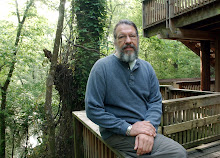The prey: bald cypress seed cones/innards
I was sitting on our back porch (nestled in the bottomland hardwood forests of northeastern Lafayette parish, Louisiana) around dusk on the evening of November 27 when my attention was drawn to the big bald cypress (Taxodium distichum) in our backyard about 25' away. Nearly leafless now, the tree is loaded with seed cones, fragments of which were clattering through its branches as they fell to the ground. Looking up, I was amazed to see a half-dozen or so male cardinals picking through the seed cones, dismantling them piece by piece. Were they actually eating cypress seeds?
The predator: northern cardinal
photo by Beth Erwin
Intrigued, I collected a couple of cones the next morning and dissected one. Surprisingly, the cones fell apart quite easily into myriad “chunks” resembling a sort of intricate, 3-D oriental puzzle, even though the exterior of each cone was still green. In between each component part was filled with a thin-but-sticky, yellow-green, and very aromatic/fragrant resin, smelling very much like “essence of Christmas tree.”
Seedwise, however, I found nothing resembling a seed; but only tiny, lime-green, worm-shaped bodies. I tasted one. It crunched like a vegetable and proved nearly as aromatic in taste as the resin did in smell. Hmmm.
So I consulted my all-time favorite native woody plant reference, Trees, Shrubs, and Woody Vines of the Southwest (Robert A. Vines, 1960; tree-lovers, ya'll really should grab a copy of this book from an online used book seller; information packed, covers 99% of Louisiana native woody plants, ultra-fine pen & ink drawings of each plant) and read me some.
Under the “fruit” section of the bald cypress citation, Vines wrote, “Ripening in October-December, cone globose [roundish], closed, rugose [roughened]....formed by the enlargement of the spirally-arranged pistillate [female] flower scales [cypress flowers have scales instead of petals]....scales angular, horny, thick [see dark, chocolate-brown cone scales in photo above]; seeds 2-winged, erect, borne under each scale...”
Hmm again. I did not see anything 2-winged and erect under each scale. All I saw were those green, crunchy, worm-like bodies. Moreover, each worm-like body came out of its own perfectly-shaped indention on the underside of the scale – like it really belonged there, you know? Was I looking at yet-underdeveloped seed? Perhaps so. Regardless, the cardinals were definitely eating it.
The day before (Nov 26) I had seen a number of cardinals fooling with the cypress cones, but I guess I figured they were just “playing” with the cones. Silly human . . .
Come to think of it, I now remember our big 2.5-year Atchafalaya Basin Bird Survey in 2002-04, where on a number of occasions I coaxed Greg Guirard to take me deep as he could into the swamp by boat so I could census the bird life there amongst permanently-flooded, pure stands of bald cypress/tupelo gum (Nyssa aquatica). As is the case with almost all climax forest systems, the diversity of bird life was relatively low in winter, consisting primarily of wood duck, osprey, several woodpecker species, yellow-rumped warbler (they're everywhere around here each winter), and, yes, cardinals. Understand, the closer to dry land you get in swamp systems, the more bird species you'll record; but once you get a half-mile or more from nearest land, the number of woodland songbirds drops percipitously. No more chickadees, titmice, gnatcatchers, kinglets, etc. Basically you're down to a few swamp specialists . . . so the, uh, robust presence of cardinals in the deep-swamp was striking.
Were those cardinals feasting on bald cypress seed? I bet they were.
Under his bald cypress citation, Vines adds interesting tidbits such as, “. . . the cone resin used as an analgesic [pain-killer] for wounds,” and, “The seeds are eaten by a number of species of birds, including wild ducks.” and “. . . has been known in cultivation in Europe [far from its native southeastern U.S. range, non?!?] since about 1640,” and “Fossil ancestors of bald cypress, at one time, covered the greater part of North America in company with the ginkoes, sequoias, and incense-cedars.”




what are those brown parts though, bill? they look like they could house the seeds... like a maple....i dunno...just wondering, i'm a silly human too!
ReplyDeleteHow cool is that??? I never knew anything ate those seed. I have grown bald cypress from seed many times and I always soak them in strong ethyl alcohol to dissolve the resin so that water can get in. It takes about a 10 minute soak as I recall. I can't imagine eating anything with resin that strong. Very interesting, Brutha Man!
ReplyDeleteThe squirrels in our yard eat the seeds all the time. They make quite the mess under the tree!
ReplyDelete